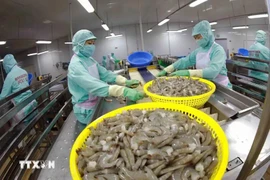Vietnam’s economy grew 8.02% in 2022, the highest rate recorded in the 2011-2022 period. The increase is three-times the growth in 2021 and exceeded the target of 6-6.5% set by the Government.
Economic indicators reflect the strong recovery of Vietnam’s economy.
It lured 27.7 billion USD in foreign direct investment. Disbursement of foreign capital stood at nearly 22.4 billion USD, up 13.5% year-on-year and the highest rate in the past 5 years.
The consumer price index rose 3.15% year-on-year, meeting the target set by the National Assembly.
Trade turnover set a new record of over 730 billion USD, with Vietnam enjoying a trade surplus of 11 billion USD, or more than three-times higher than in 2021.
Tourism has also been a bright spot for the economy. After Vietnam re-opened its borders to foreign visitors from March 15, the tourism sector has gradually recovered and posted growth.
Foreign visitors exceeded 3.66 million in 2022, 23-times higher than in 2021.
Domestic visitors surpassed 101 million, a rise of 168% year-on-year.
Notably, the economic structure shifted in a positive direction. The agro-forestry-fisheries sector accounted for less than 12% of GDP, while the industry and construction sector made up 38% and the service sector 41%.
The country’s digital economy contributed significantly to the economy, with revenues estimated at 148 billion USD, an increase of more than 10% year-on-year.
Vietnam leads Southeast Asia in digital economic growth. Its total value of digital economic goods in 2022 is estimated at 23 billion USD, up some 28% year-on-year.
Vietnam’s economic stability has been recognised by international ratings agencies such as Moody’s, Standard & Poor’s, and Fitch Ratings.
At the end of 2022, Fitch Ratings ranked Vietnam BB with a positive outlook. Moody’s Investors Service upgraded the country’s long-term national credit rating to Ba2 from Ba3, with a stable outlook.
Media in countries such as the US, Germany, Russia, Thailand, Singapore, and Japan have cited the confidence of experts and businesses in the stability and development of Vietnam’s economy.
These outcomes were attributed to the timely guidelines and decisions from the Party, the State, and the Government in the new normal, re-opening Vietnam’s border to foreign visitors, reforming administrative procedures, improving the investment climate, and stepping up anti-corruption efforts.
Major decisions were made for the first time to create important foundations and to orient the country’s socioeconomic development in the years to come.
They include Politburo resolutions on socioeconomic development and ensuring national defence and security in the six economic regions, and the Government’s Resolution on the National Master Plan for the 2021-2030 period and vision to 2050.
Vietnam encountered many difficulties and challenges in 2022, but most analysts have expressed a belief that it will continue to overcome the difficulties and maintain growth next year thanks to its resilience and adaptability to fluctuations./.



















